- Submissions

Full Text
Trends in Textile Engineering & Fashion Technology
Integrated Textronic System to Control Health of Small Children
Adam Jakubas* and Ewa Łada Tondyrap
Faculty of Electrical Engineering, Czestochowa University of Technology (CUT), Poland
*Corresponding author: Adam Jakubas, Faculty of Electrical Engineering, Czestochowa University of Technology (CUT), 42-201 Czestochowa, Poland
Submission: January 12, 2018; Published: March 12, 2018

ISSN: 2578-0271 Volume2 Issue1
Abstract
The fundamental aim of the research is the protection of life and health of small children by using modern technologies and materials. Integration of the measurement of temperature with a breath monitor would make it possible to carry out a comprehensive monitoring of the health state for babies and small infants. This work presents design and testing of the textronic system for monitoring vital parameters of small children and infants baby tex.
Keywords: Textronic material; Temperature measurement; Breath monitoring
Introduction
Every parent has been subject to stress due to the state of health of their children. It is very often related to night shifts,listening to the breathing rhythm and attempts to determine the proper temperature of the infant's body.
Parents often purchase different devices and tools aimed at helping during babies' illnesses to monitor their state of health. Examples may be digital thermometers, close up thermometers, electronic nannies, breath monitors etc. Variegation and number of the possessed devices pose a number of problems related to their storage, mobility (e.g. during vacations, travels), frequency of measurements, detection of variations (e.g. during the night), analysis of the reasons for variations and occurrences of interferences. The research team wishes to address the aforementioned problems by development of the Baby Tex system for monitoring vital functions of babies and infants, which is a comprehensive solution, joining the functionality of baby garment with components of measurement electronics.
Design
Minimization of electronic devices and development of novel textronic materials have made it possible to integrate specialized sensors monitoring parameters life of humans into everyday garments [1]. The application of sensors in children's clothes that measures e.g. blood pressure, pulse, breath frequency, temperature, ECG, etc. Makes it possible to detect anomalies that might be a threat to health or life ahead of time. In the proposed baby tex system two parameters are controlled within a single monitoring system, namely: body temperature and frequency of breath rhythm.
Temperature measurement in the case of small children is not only a medical problem. Difficulties with keeping the child calm and related inaccuracy of measurement are a significant problem for a proper examination in the home conditions. Additionally, abrupt temperature variations in the 24h cycle indicate the need to monitor the infant's body temperature constantly. Body temperature of a healthy new-born is not constant, it varies within one degree, from 36, 6 up to 37, 5 °C. This is related to immaturity of thermo-regulation system and varying activity of hormones during the 24hr cycle. On the other hand, an extended body heat (above 38 °C) increases the demand of the organism for oxygen, water and energy, leads to dehydration and exhaust and hampers the immunity reactions. It is thus crucial to control infant’s body temperature. At present temperature may be controlled with several methods: in the anus, at the forehead, under the arms, in the ear or in the mouth. Available thermometers require several seconds for carrying out the measurement, if the child is anxious and moves constantly, only the approximate body temperature is recorded and there is no guarantee that the measurement is correct. Only a 24h instant monitoring of body temperature gives a realistic state of health of the infant. At present, most often applied methods to measure temperature in smart textiles are based on conventional sensors like thermo-elements, thermistors and semiconductor sensors. This results from the tiny dimensions as well as from the requirements concerning the accuracy of measurements. Classic temperature sensors placed on garment surface or in the inner layer area may cause a substantial discomfort for the users and skin irritation due to their stiffness. In order to eliminate this deficiency, the temperature sensor should be incorporated into the textile structure to the largest possible extent.
Another parameter important from the stand point of proper diagnostics fot the state of health of an infant is monitoring its breath, including the sleep phase. From the medical stand point, loss of breath or instant stop of breath is one of the reasons of SIDS (Sudden Infants' Death Syndrome) [2]. It may be due to a number of reasons, above all it follows from the immaturity of the breath system, it may also happen during infections. Continuous guarding at the child's side is inefficient and above all impractical. Much more functional method is the use of a device, which makes it possible to monitor the infant's breath. The flat plates placed under the cot mattress are in common use. They capture the breaks during breathing. However their use is limited: carrying out the measurement is possible only on the spot, where they are installed, their limited area may also cause false alarms. The weakest point and limitation of these devices is their lack of mobility. The advantage is that the monitor is installed once. Moreover such monitors are sensitive against external vibrations. The measurement setup (the plates) does not distinguish the breath of the baby from air circulation or other vibrations.
Development of a system monitoring appropriate life station for data archiving and the application for mobile devices parameters, taking into account both breathe control and 24h and PCs (Figure 1 & 2).temperature measurement, shall make it possible to supervise the state of health of minor infants in the household conditions, also in the case of fewer babies. It is crucial to develop a system adjusted to the requirements of babies. The application of textile technology with integrated measurement system shall make it possible to combine the biometric sensors with every-day garments. In the case of infants, it is necessary to provide the appropriate level of comfort and a sufficient ease of movements. From the technical stand point this is related to a sufficient elasticity of the material and sensors and measurement reliability [3].
Integration of the aforementioned measurement of temperature with a breath monitor would make it possible to carry out a comprehensive monitoring of the health state for babies and small infants [4]. The baby tex in its composition includes: the comfortable intelligent underwear for everyday use with textile sensors; the detachable control unit with microcontroller; the base Development of a system monitoring appropriate life station for data archiving and the application for mobile devices parameters, taking into account both breathe control and 24h and PCs (Figure 1 & 2).
Figure 1: A simplified working scheme for the baby tex system.
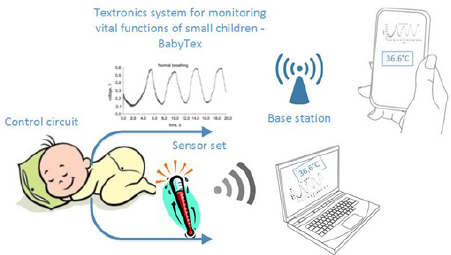
Figure 2: The textronic system baby tex exemplary implementation.
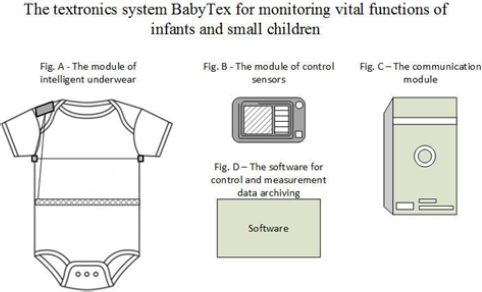
A textronic supervisory system monitoring life parameters of infants shall consist of a comfortable every day underwear, a control unit, a base station with a communication module and an application for mobile devices and PC. The intelligent garment shall be equipped with elastic sensors of breath rhythm and body temperature as well as of a detachable electronic system (controller) responsible for data acquisition from the sensors, as well as for communication within the system. A wireless base station would extend the garment's capabilities with the function of signaling an anomaly with acoustic and / or visual marks as well as with the use of a GSM network. The self developed software being the part of the system would make it possible to monitor locally and remotely many sets of smart underwear (using e.g. a Wi-Fi network or GSM) with commonly used smart phones, tablets and computers [5].
Successive requirements refer to the settlement of optimal placement of sensors, fulfilling at the same time the requirement that the kids’ underwear must not be tight fitting. The high performing microchip AT mega 328 is responsible for the functioning of the entire system. The microchip reads the data from the sensors, analysis it and allows communications with a user. The children clothes prototype with the sensors of vital functions is show in Figure 3.
Figure 3: The prototype of the children’s intelligent clothes baby tex.
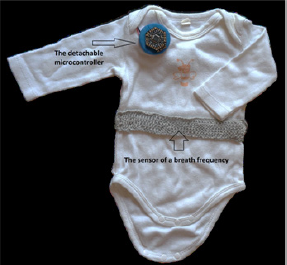
Measurement
Figure 4: TMeasurement of breath rhythm during one minute.
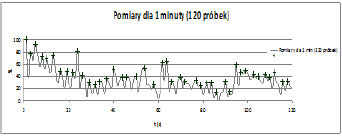
The first analyzed issue was the textile sensor of breath rhythm. The measurements have been carried out in order to verify the usefulness of the developed textile sensor and to assess the breath rhythm of a three month old baby. A prototype of the belt has been equipped with sensors made of electro conductive fibers. It based on ribbing stitch described in [6,7]. The relative measurement of resistance changes has been carried out for a one minute period, what has been presented in Figure 4. Abrupt resistance changes, which may be noticed, result from additional activity of the baby movements not related to breathing.
Additionally in Figure 5 a chart depicting the number of local maxima in individual one minute long periods, reflecting the number of breaths of the baby, is shown. The obtained measurements,some 29-38 aspirations, correspond to medical data i.e. 30+/-8 aspirations per minute.
Figure 5: The number of recorded aspirations.

In the subsequent stage of initial research the thermo graphic analysis of two babies, depicted in Figure 6, has been carried out. In this way the choice of optimal placement of temperature sensors was examined. The temperature measurement is carried out using 2 digital sensors with medical accuracy. The sensors are integrated in the structure of the clothes under the armpits. The location of the sensors were chosen based on studies of thermography (Figure 6). Exemplary results of the measurements are presented in Figure 7.
Figure 6: Temperature distribution a) for a baby 3-month old, b) for an infant (12-month old).

Figure 7: Textronic temperature sensor [6].

For the demands of the experiment two types of temperature (an analogue one and a digital one) were applied. The analogue temperature sensor MCP9700 features small dimensions and a linear dependence of output voltage on temperature variations (10mV/°C) as well as small current consumption (12μA).
Another sensor was made using the integrated circuit TMP006 [8]. This is a remote temperature sensor in order to measure temperature it avails of infrared radiation emitted by the object under examination. For communication with the control system the interface I2C was used. In Figure 8 the measurements of body temperature recorded with two sensors integrated with garment during 20 seconds are presented. In dependence on the type of sensor used different measurement problems were encountered. In the case of the analogue sensor the voltage drop in the signal line caused e.g. by the resistance variation due to baby movements, affects the measurement accuracy. On the other hand, in the case of digital sensor, the troublesome are interferences due to electric charges induced in the garment.
Figure 8: Body temperature measurements with the sensors of different accuracy.
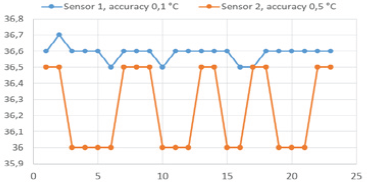
The last component examined by team members were selected electric parameters of textile signal and supply lines deposited with a sewing machine. The aim of the study was the assessment of such lines in connection and development of electronic systems for use in textronic.
Conclusion
Preliminary studies have proven the functionality of the considered solutions for application in baby and infant garments. As the result of study, the research team has filed with Polish Patent Office an application for granting the protective law for user pattern "Textronic garment for babies", No. W.124588. This indicates the need to carry on further research and development of the proposed system.
References
- Borowik L, Jakubas A (2015) Measurements of the selected electrical parameters of textile materials for applications in smart clothing. Przegl^d Elektrotechniczny R 9: 115-117.
- Kulus M, Krauze A, Bartosiewicz W (2007) Obturacyjny bezdech senny u dzieci. Pneumologia i Alergologia Polska 75(1): 23-27.
- Jakubas A (2015) Tests and measurements of chosen electrical parameters of textile signal lines deposited with machine method. Przegl^d Elektrotechniczny 12: 117.
- Jakubas A, Lada TE, Nowak M, Margol M, Lipinska OA (2015) A concept of a textronic system for measurement of vital functions of infants. Przegl^d Elektrotechniczny 12: 121.
- Nowak M, Jakubas A, Lada TE (2015) An analysis of microprocessor measurement systems for applications in textronic. Przegl^d Elektrotechniczny 12: 176.
- Jakubas A, Lada TE, Nowak M (2017) Textile sensors used in smart clothing to monitor the vital functions of young children. Progress in Applied Electrical Engineering (PAEE).
- Jakubas A, Lada TE (2018) A study on application of the ribbing stitch as sensor of respiratory rhythm in smart clothing designed for infants. The Journal of the Textile Institute.
- Catalogue entry TMP006.
© 2018 Adam Jakubas, et al. This is an open access article distributed under the terms of the Creative Commons Attribution License , which permits unrestricted use, distribution, and build upon your work non-commercially.
 a Creative Commons Attribution 4.0 International License. Based on a work at www.crimsonpublishers.com.
Best viewed in
a Creative Commons Attribution 4.0 International License. Based on a work at www.crimsonpublishers.com.
Best viewed in 







.jpg)






























 Editorial Board Registrations
Editorial Board Registrations Submit your Article
Submit your Article Refer a Friend
Refer a Friend Advertise With Us
Advertise With Us
.jpg)






.jpg)














.bmp)
.jpg)
.png)
.jpg)










.jpg)






.png)

.png)



.png)






